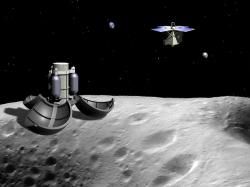A giant asteroid named Apophis has a one in 45,000 chance of hitting the Earth in 2036. If it did hit the earth it could destroy a city or a region. A slate of new proposals for addressing the asteroid menace was presented today at a recent meeting of the American Association for the Advancement of Science in San Francisco.
One of the Lifeboat Foundation projects is an Asteroid Shield and the issues and points discussed are in direct alignment with Lifeboat. The specific detection and deflection projects are in the Lifeboat Asteroid Shield project.
Edward Lu of NASA has proposed “gravitational tractor” is a spacecraft—up to 20 tons (18 metric tons)—that it could divert an asteroid’s path just by thrusting its engines in a specific direction while in the asteroid’s vicinity.
Scientists also described two massive new survey-telescope projects to detect would-be killer asteroids.
One, dubbed Pan-STARRS, is slated to begin operation later this year. The project will use an array of four 6-foot-wide (1.8-meter-wide) telescopes in Hawaii to scan the skies.
The other program, the Large Synoptic Survey Telescope in Chile, will use a giant 27.5-foot-wide (8.4-meter-wide) telescope to search for killer asteroids. This telescope is scheduled for completion sometime between 2010 and 2015.
David Morrison, an astronomer at NASA’s Ames Research Center, said that “the rate of discoveries is going to ramp up. We’re going to see discoveries being made at 50 to 100 times the current rate.”
“You can expect asteroids like Apophis [to be found] every month.”
Schweickart, the former astronaut, thinks the United Nations needs to draft a treaty detailing standardized international measures that will be carried out in response to any asteroid threat.
His group, the Association of Space Explorers, has started building a team of scientists, risk specialists, and policymakers to draft such a treaty, which will be submitted to the UN for consideration in 2009.
